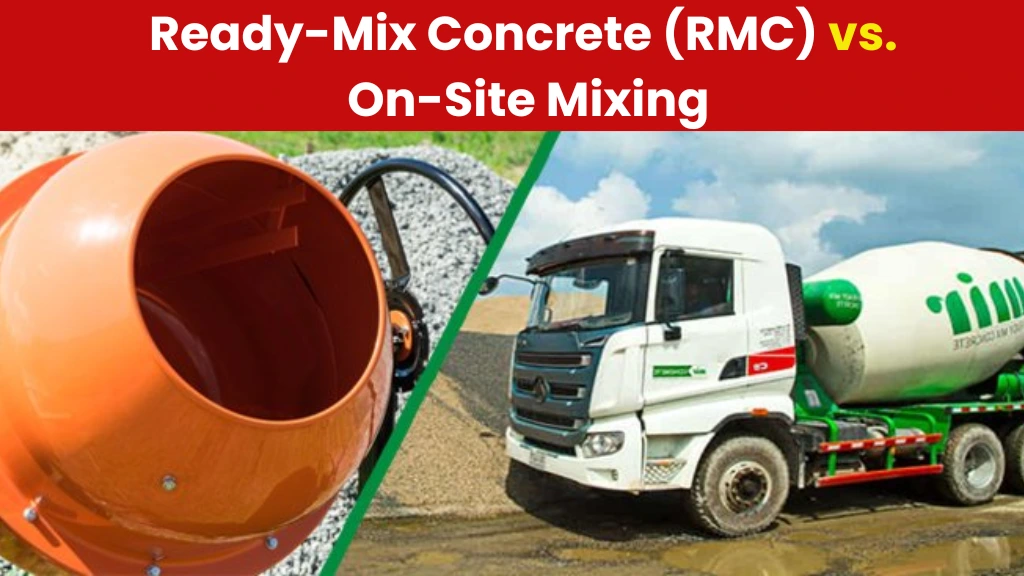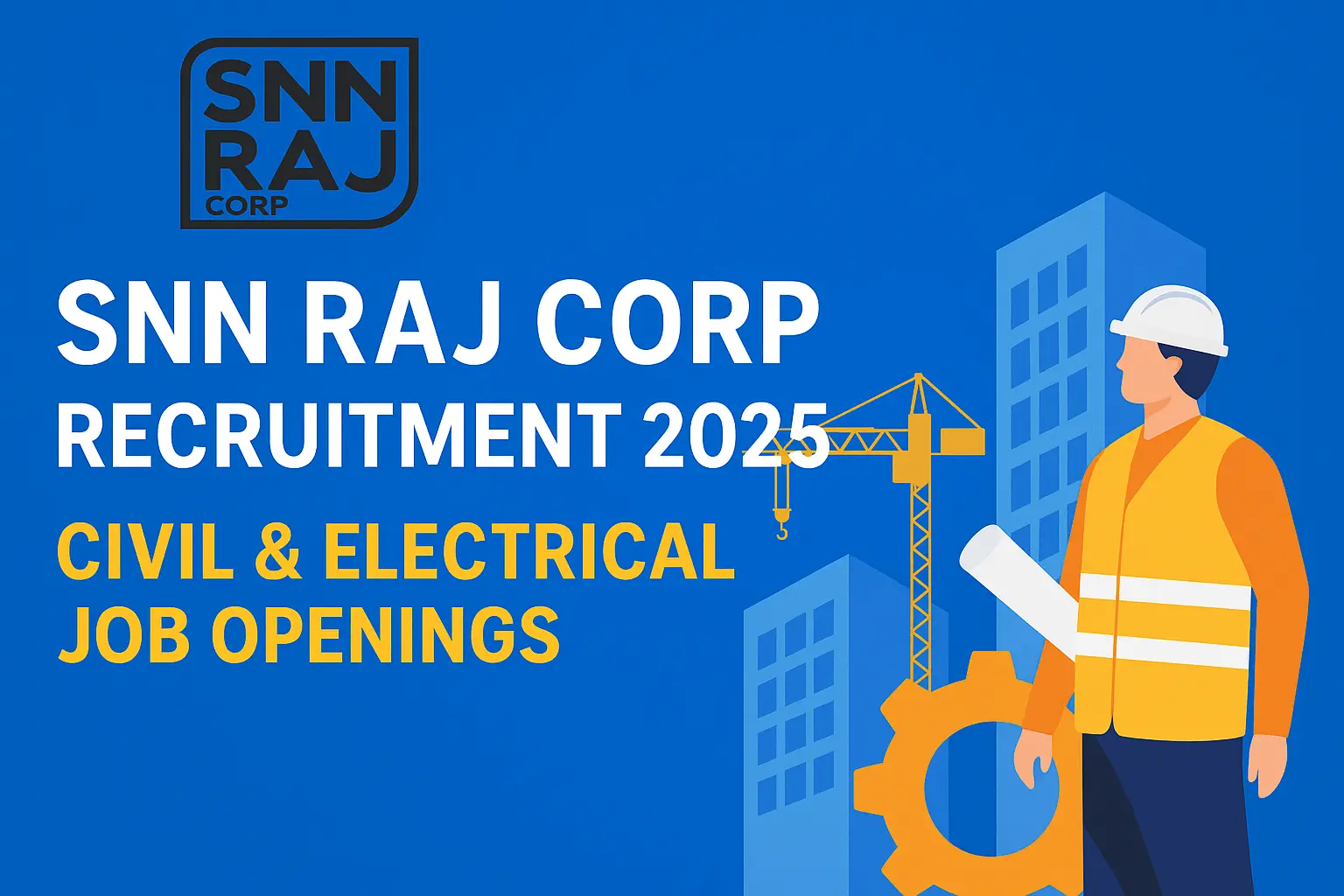Concrete is the foundational material in present-day construction because builders use it to build skyscrapers, bridges, residential buildings, and roadways. Ready-mix concrete (RMC) and On-Site Mixed Concrete methods are the main choices for concrete supply. The determination of concrete supply choices depends on various project-specific aspects, including size constraints and costs, quality control standards, and logistical requirements.
This article thoroughly evaluates RMC and on-site mixing to explain how each method offers advantages, sets constraints and costs, and affects the environment for selecting the most appropriate construction solution.
What is Ready-Mix Concrete (RMC)?
Readymix Concrete (RMC) is a pre-mixed concrete solution produced in a batching plant that is loaded onto trucks and delivered to the construction site in a state of continued use. It is made with a definite proportion of cement, aggregates, water, and admixtures. The mixture is transported in transit mixers to avoid hardening by the time the material reaches the site.
Advantages of RMC
1. Consistent Quality & Strength
- RMC made under controlled condition gives a uniform mix preventing variations in the quality.
- The automated batching plants work by the strict ratio of the raw materials.
2. Time Efficiency
- By pre-mixing the concrete, this means no on-site preparation is needed for construction.
- Faster turnaround times are great for large projects.
3. Reduces Material Wastage
- RMC plants are an environmentally friendly option because it does away with the waste from the precise measurement.
- Usually, this results in excess materials being disposed of on-site.
4. Labor & Space Optimization
- RMC does not need large storage areas for sand, gravel, and cement.
- Lessen labor costs that reduce in minimum number of workers required for mixing and measuring material.
5. Higher Workability & Durability
- Admixtures are used to improve workability, pumpability, and overall strength.
- It is more weather and wear-resistant than traditional mixing offers.
Drawbacks of RMC
1. Transportation Challenges
- Otherwise, RMC has to be delivered within a specific certain time frame to avoid premature setting.
- Reductions in the portability of the mix can result from traffic delays.
2. Higher Initial Cost
- On-site mixed concrete is more expensive per cubic meter than that of RMC.
- However, it might still be economically feasible in the future due to savings in labor and wastage.
3. Limited Flexibility for Small Projects
- In most cases, ordering RMC in bulk is not practical or feasible for smaller projects.
- Better control over smaller batches is given by on-site mixing.
What is On-Site Concrete Mixing?
Concrete mixing on site is the preparation of concrete at the construction site by manually mixing cement, sand, aggregates, water, and optional admixture. It is commonly used in small—to medium-sized projects where proper control or variation on material proportion is required.
Advantages of On-Site Mixing
1. Greater Flexibility & Control
- It allows the contractor to adjust the mix proportions easily according to the immediate project requirements.
- Useful for customized mix designs and small-volume concrete requirements.
2. No Wastage Due to Transportation
- When there is no delay or setting concern during the transportation of concrete on demand, no special precaution is necessary.
3. Lower Initial Cost
- You do not need to pay for the operation of batching plant or transportation fees.
- Ideal for budget-conscious projects.
4. Suitable for Remote Locations
- On-site mixing is the only viable proposition in the areas where RMC plants are not available.
- Useful for construction in hilly terrains and rural areas.
Drawbacks of On-Site Mixing
1. Inconsistent Quality & Strength
- The durability is affected as there are often variations in the material proportions of manually mixed materials.
- Also, a set of skilled workers is needed to maintain uniformity.
2. Time-Consuming & Labor-Intensive
- It makes it a long manual process of constructing concrete.
- Labor costs increase as there are more workers needed.
3. Storage & Wastage Issues
- Raw materials require an unnecessary increase in site clutter because it need storage space.
- If the materials are not stored properly, the material can waste and can be contaminated.
4. Limited Use for Large-Scale Projects
- For high-volume concrete needs, on-site mixing is not possible.
- On-site mixing struggles to provide a continuous and continuous supply of supply on large projects.
Which is Better: RMC or On-Site Mixing?
Choose RMC If:
Your project requires large volumes of concrete.
You need high-strength and consistent concrete quality.
You want to reduce labor costs and speed up construction.
Your site has limited storage space for raw materials.
Choose On-Site Mixing If:
Your project is small-scale and requires only small batches.
You need to adjust the mix ratio on-site.
You are working in remote locations where RMC delivery is not feasible.
You have budget constraints and can afford more labor costs instead of RMC.
Conclusion
Ready Mix Concrete (RMC) vs. on-site mixing is decided on a whole array of factors, ranging from project size to cost, to quality control, to labour availability and site conditions, weather conditions, geographical condition, transportation range etc.
- If speed and efficiency are important as well as high-quality, consistent concrete, then RMC will be the best choice for large-scale projects. It cuts labor expenses, material loss, as well as storage issues, and is more reliable and sustainable in urban construction.
- Suitable for small or remote projects where the flexibility of mix design, cost control, and material changes are primordial, On-Site Mixing is. However, it involves more labor, more time, and takes up more space, and has quality issues as it is mixed by hand.
RMC has been found in most cases to be the preferred option of modern construction on the grounds of its precision, durability, and time-saving effect. Onsite mixing is still a viable option, but only if you are working on a project that is on a budget or remote.
Top 5 Civil Engineering Software for Structural Design & Analysis in 2025
FAQs Ready-Mix Concrete (RMC) vs. On-Site Mixing
1. Is on-site mixing of concrete more expensive than ready-mix concrete?
Indeed, there is an initial cost of RMC with transportation and plant operation expenses but in the long run, it saves due to lessening material waste, labor costs, and project delays.
2. Is RMC suitable for small size activities like apartments, shopping centers, and many more projects?
Usually, RMC is not cost-effective for very small projects, but some suppliers do produce small batches to accommodate alternative needs.
3. What are the main disadvantages of on-site mixing?
Less labor, time and storage space are required, but mixing on site results in inconsistent quality because manual proportioning varies.
4. What is the more environmentally friendly method?
The main superiority of the RMC is that its less wastage of raw material and the dust pollution at the construction site is less.
5. Can the RMC be designed for projects with project requirements?
RMC plants to have customized mix designs, especially admixtures for additional durability, strength, and workability.











I every time spent my half an hour to read this website’s posts all the time along with a cup of coffee.